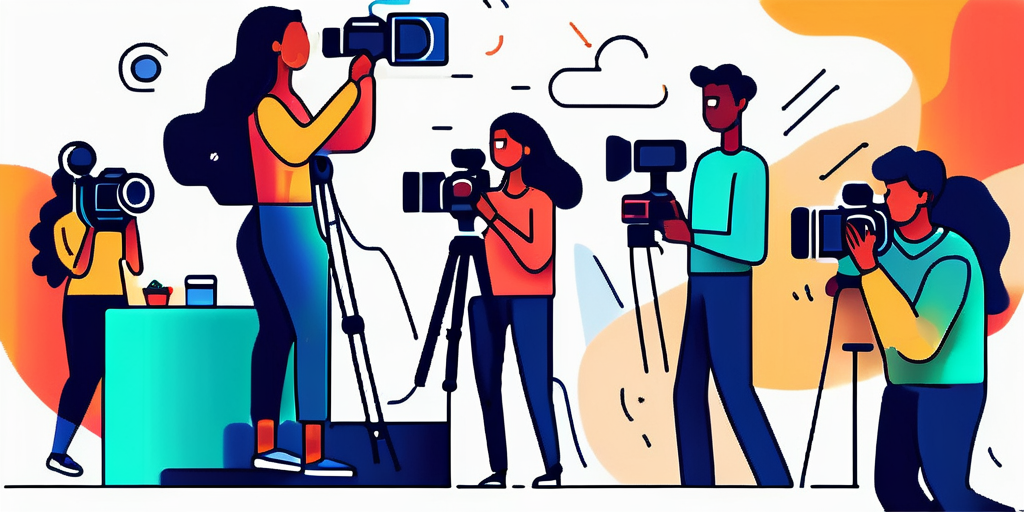Leveraging Video Content for Nonprofits: A Powerful Tool for Success

In today’s digital age, video content has become an incredibly powerful tool for nonprofits. With the ability to engage, educate, and inspire viewers, videos have the potential to make a lasting impact on the audience. This article will explore the various reasons why video content is crucial for nonprofits and provide actionable steps to leverage video content effectively. Additionally, we will discuss strategies to maximize the reach of video content and measure its success.
Understanding the Power of Video Content
Visual storytelling is a compelling way to convey a nonprofit’s mission and message. By combining visuals, audio, and narratives, videos have the ability to evoke strong emotions and create a connection with viewers. The power of video lies in its ability to engage multiple senses, making it more memorable and impactful than other forms of content.

The Impact of Visual Storytelling
Visual storytelling through videos allows nonprofits to showcase the people, places, and stories behind their work. By capturing real-life moments and experiences, organizations can create a deeper understanding and emotional connection with their audience. Through visual storytelling, nonprofits can humanize their cause and motivate viewers to take action.
Why Video Content is Crucial for Nonprofits
Video content has proven to be highly effective in driving engagement and raising awareness. In today’s fast-paced digital world, videos have become the preferred medium for information consumption. They are easily shareable, can be accessed across different platforms and devices, and have higher chances of going viral. By leveraging video content, nonprofits can reach a wider audience and amplify their message.
Moreover, video content allows nonprofits to showcase their impact in a more tangible and compelling way. Through visuals, viewers can witness the transformation and positive change that the organization brings to individuals and communities. This firsthand experience can leave a lasting impression and inspire viewers to support the cause.
Additionally, video content provides an opportunity for nonprofits to collaborate with influencers and thought leaders in their field. By featuring these individuals in their videos, nonprofits can tap into their existing audience and expand their reach. This collaboration not only increases visibility but also adds credibility to the organization’s work.
Steps to Leverage Video Content for Your Nonprofit
Now that we understand the power and importance of video content, let’s explore the steps nonprofits can take to effectively leverage this tool:

Identifying Your Video Content Goals
Before diving into video production, it’s crucial to define your goals. Determine what you want to achieve with your videos. Is it to raise awareness, educate the audience, promote a campaign, or encourage donations? By setting clear goals, you can tailor your video content to achieve those objectives.
Creating a Compelling Narrative
A compelling narrative is key to capturing the viewer’s attention and making an impact. Craft a story that resonates with your audience, highlights your organization’s work, and showcases the individuals or communities benefitting from it. Stories that evoke emotions and create a connection are more likely to inspire action.
Tips for Producing High-Quality Videos
Producing high-quality videos doesn’t necessarily require a big budget. Use these tips to produce videos that captivate your audience:
- Invest in good lighting and sound equipment to improve the overall quality.
- Keep videos concise and focused, aiming for a length that is suitable for your target audience.
- Use visuals that complement the narrative and engage viewers.
- Include captions or subtitles to cater to different viewers, including those with hearing impairments.
- Test your videos on different devices and platforms to ensure compatibility and optimal viewing experience.
Now, let’s delve deeper into each of these tips to help you produce truly exceptional videos:
Firstly, investing in good lighting and sound equipment can significantly enhance the quality of your videos. Proper lighting ensures that your subjects are well-lit and visually appealing, while good sound equipment ensures clear and crisp audio, avoiding any distractions or difficulties in understanding the message you’re conveying.
Secondly, keeping your videos concise and focused is essential to maintain your audience’s attention. In today’s fast-paced world, people have limited time and attention spans. By delivering your message in a concise manner, you increase the chances of your viewers staying engaged and absorbing the information you’re sharing.
Thirdly, visuals play a crucial role in capturing and retaining your audience’s interest. Use relevant and captivating visuals that complement your narrative, whether it’s through stunning imagery, infographics, or animations. Visuals not only make your videos more visually appealing but also help convey complex ideas or data in a more digestible format.
Additionally, including captions or subtitles in your videos can make them more accessible to a wider audience. By providing text alongside the audio, you ensure that viewers with hearing impairments can still understand and engage with your content. Moreover, captions can also be beneficial for viewers who prefer to watch videos in a sound-sensitive environment or in a language different from the one spoken in the video.
Lastly, testing your videos on different devices and platforms is crucial to ensure that your content reaches its full potential. Different devices and platforms may have varying technical specifications and requirements, such as screen sizes, resolutions, or video formats. By testing your videos across a range of devices and platforms, you can identify and address any compatibility issues, ensuring that your audience can enjoy a seamless and optimal viewing experience.
By following these tips and expanding your knowledge of video production, you can create compelling and impactful videos that effectively leverage the power of visual storytelling to further your nonprofit’s mission.
Maximizing the Reach of Your Video Content
Creating great video content is only half the battle. To ensure maximum impact, nonprofits should focus on maximizing the reach of their videos.

One way to expand the reach of your video content is by utilizing social media platforms. Platforms such as Facebook, Instagram, and YouTube offer a wide reach for sharing video content. By creating accounts on these relevant platforms, you can tap into a larger audience base. It is important to optimize your videos for each platform’s requirements, ensuring that they are formatted correctly and visually appealing. Regularly sharing your videos on these platforms, engaging with your audience, and encouraging them to share your content can help you reach a wider network.
In addition to social media, implementing video SEO (Search Engine Optimization) techniques can also help increase the visibility and reach of your videos. Researching relevant keywords and incorporating them into your video titles and descriptions can improve your videos’ ranking in search engine results. Furthermore, using tags and captions effectively can enhance the discoverability of your videos. By optimizing your videos for search engines, you can attract more viewers and expand your reach.
Another effective strategy for maximizing the reach of your video content is collaborating with influencers and partners. Partnering with influencers who have a large following in your target audience can significantly expand your video’s reach. These influencers can share or feature your video on their platforms, exposing your content to a wider audience. Additionally, consider collaborating with other nonprofits to create joint video campaigns. By joining forces, you can amplify each other’s reach and impact, reaching a larger audience and creating a greater social impact.
By utilizing social media platforms, implementing video SEO best practices, and collaborating with influencers and partners, nonprofits can maximize the reach of their video content. These strategies can help ensure that your videos are seen by a larger audience, increasing the impact and effectiveness of your message.
Measuring the Success of Your Video Content
Measuring the success of your video content is essential for understanding its impact and making informed decisions for future strategies. But how exactly do you go about measuring this success? In this article, we will delve deeper into the topic and explore some key strategies for evaluating the effectiveness of your video content.
Key Performance Indicators for Video Content
Identifying key performance indicators (KPIs) that align with your goals is crucial when it comes to measuring the success of your video content. While views and engagement rates are commonly used metrics, it’s important to consider other KPIs that may be more relevant to your specific objectives. These could include click-through rates, donations, or conversions. By tracking these KPIs, you can gain a comprehensive understanding of the effectiveness of your video content and make data-driven improvements.
Analyzing Viewer Engagement and Feedback
Monitoring viewer engagement is another vital aspect of measuring the success of your video content. Beyond just views, it’s important to analyze metrics such as watch time, likes, comments, and shares. These metrics provide valuable insights into how your audience is interacting with your videos. Additionally, paying attention to audience feedback and comments can give you a deeper understanding of their thoughts and feelings. By actively listening to your audience, you can refine your video content and better cater to their preferences and needs.
Adjusting Your Video Content Strategy Based on Data
Once you have gathered the necessary data and insights from your video analytics, it’s time to adjust and optimize your video content strategy. Experimentation is key here. Try different types of videos, formats, and platforms to identify what resonates best with your target audience. By continuously iterating and refining your strategy, you can improve the effectiveness of your video content over time.
Expanding your reach through social media, implementing video SEO best practices, and measuring the success of your video content using relevant KPIs are all important steps to consider. However, it’s important to note that measuring success is an ongoing process. It requires continuous monitoring, analysis, and adjustment to ensure that your video content is consistently meeting your goals and making a lasting impact.
So, the next time you create a video for your nonprofit organization, remember to keep these strategies in mind. By understanding the power of video content, setting clear goals, and following these steps, you can leverage this powerful tool effectively and make a lasting impact in the nonprofit sector.
Ready to take your nonprofit’s video content to the next level? BlueWing is here to help you harness the power of paid social media and search to amplify your message and achieve sustainable growth. With our expertise in the Google Ad Grants program and a commitment to keeping you updated every step of the way, we’re dedicated to outperforming industry benchmarks and maximizing your impact. Contact us today and let’s create a robust digital presence for your organization together.


